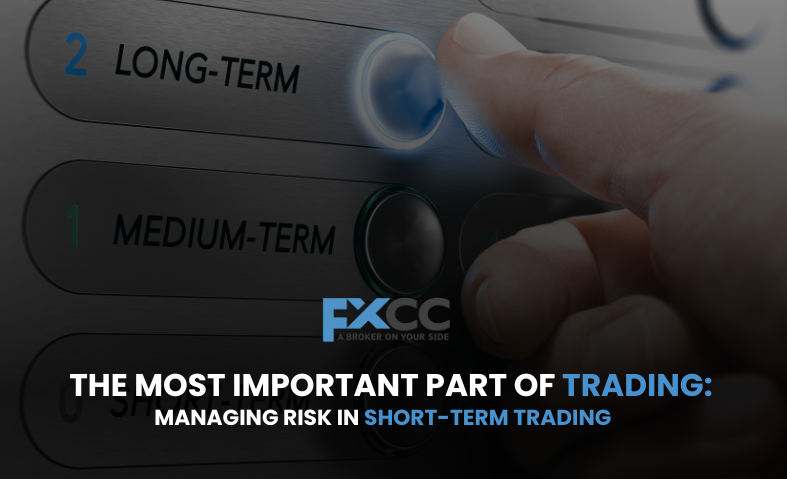Many people find short-term trading interesting because it moves quickly and can lead to big profits quickly. But there is one thing that is true about the appeal of quick profits: it’s a high-stakes game. It’s not enough to just choose the appropriate stocks; you also need to know how to handle risk well. When you trade in the short term, choices are made in seconds and prices change all the time. A strong risk management plan isn’t a luxury; it’s what keeps you alive. It’s the structure that keeps your money safe, limits your losses, and makes sure you can keep playing for a long time. One incorrect choice can wipe away a whole string of profitable deals if you don’t have it. This article will explain the most important parts of risk management in short-term trading, such as how to create stop-losses, how to size your positions, and how to keep your emotions in check.

Figuring Out How Much Risk You Can Handle
You need to know how much risk you’re willing to take before you even start trading. This isn’t simply a number; it’s a checkup on your finances and yourself. How much of your trading money are you okay with losing on one trade? A good rule of thumb is to only put 1% to 2% of your total trading capital at risk on each deal. If you have a trading account with $10,000 in it, you should only risk $100 to $200 per trade. This proportion may seem modest, yet it is very important for safety. It stops one big loss from ruining your whole account. Setting this restriction means that you will never go beyond it, no matter how sure you are about a deal. This discipline is the first thing you need to do to keep your money safe from decisions made on a whim or out of emotion.
The Stop-Loss Order’s Strength
Some people say that the stop-loss order is the most crucial instrument for short-term traders. A stop-loss tells a broker to sell a security when it hits a specified price. It’s a set point for getting out of a lost trade. The main goal of a stop-loss is to keep losses to a minimum. If you buy a stock for $50 and set a stop-loss at $49, your position will be sold automatically if the price lowers to that level. This simple step removes the emotional aspect of a losing trade. If a trader doesn’t have a stop-loss, they can keep a losing position, expecting it would turn around, but it will just keep going down. A stop-loss makes you stick to the rule of reducing your losses short. To use a stop-loss properly, you need to put it in the right place, usually below a crucial support level, based on technical analysis rather than just a random amount.
The Key to Consistency: Position Sizing
Position size is the act of choosing how many contracts or shares to buy or sell. It has a direct connection to how much danger you’re willing to take. Once you know how much risk you’re willing to take on each transaction (for example, 1% of your account), you can figure out how big your position should be. The formula is easy: Position Size = (Account Risk) / (Distance to Stop-Loss). Let’s go back to the $10,000 account and the rule that says you can only lose 1%. You can only lose up to $100 on each trade. Your risk per share is $1 if you buy a stock for $50 and set your stop-loss at $49. So, you can buy 100 shares for $100 ($100 / $1 = 100 shares). You can still buy 100 shares if you buy a different stock for $25 and set a stop-loss at $24. Your risk per share is still $1. But if your stop-loss is at $23, your risk is $2 per share, thus you would only buy 50 shares ($100 / $2 = 50 shares). No matter how volatile the trade is, proper position sizing makes sure that it won’t hurt your account too much. It’s how you use your risk tolerance in real life.
The Ratio of Reward to Risk
The reward-to-risk ratio is an important part of a trading strategy that makes money. This is the difference between the possible profit (the reward) and the possible loss (the risk) on a trade. A common goal in short-term trading is to have a reward-to-risk ratio of at least 2:1. This means you want to make at least twice as much as you are willing to lose. If your stop-loss is set to lose $100, you should be trying to make at least $200. This ratio is strong because you can be incorrect more often than you are right and still make money. You will still be in the green if your trading method has a 40% win rate and a 2:1 reward-to-risk ratio. A solid reward-to-risk ratio is what makes strategic trading different from gambling. Over time, it offers your strategy a mathematical edge.
The Importance of Psychology and Discipline
The human aspect is a big part of risk management, even with the finest plan. Fear, greed, and impatience are things that short-term traders should avoid. Fear can make you leave a winning deal too soon, which means you miss out on possible rewards. If you’re greedy, you can cling onto a profitable deal for too long and then lose it. If you’re impatient, you can trade too much or get into a position that doesn’t fit your needs. This is where self-control comes in. A trader needs to be disciplined enough to always stick to their plan. This means:
- Always putting in a stop-loss.
- Never put more than your set proportion at risk.
- Sticking to the ratio of rewards to risks.
- Don’t trade when you’re feeling emotional.
Not only are the best traders skilled at technical analysis, but they also know how to control their own minds. They know that a trade is simply a number and that feelings shouldn’t get in the way of a good plan.

The Bottom Line
The key to success in short-term trading is managing risk. It’s not a suggestion; it’s a rule that can’t be broken. You can protect your money and let it grow over time by setting your risk tolerance, placing stop-loss orders, sizing your positions wisely, keeping a good reward-to-risk ratio, and being disciplined. It’s the difference between betting and having a firm that trades for a living. If you learn how to manage your risk, you’ll be able to make money no matter how the market changes.


